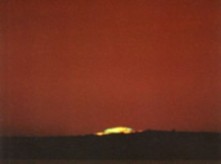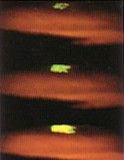
THE AIRLINE PILOTS FORUM & RESOURCE
Green Flashes |
| Source: Excerpt from The Book " Weather " |
 |

On very rare occasions, when the Sun is on the
point of disappearing below the horizon, a green light
will be visible above it for a few seconds. This phenomenon is known as a green flash. Sunlight consists of colors of different wavelengths, which are scattered by dust particles as they pass through the atmosphere. This
causes the color of our sky to vary from blue through to red according to the amount of dust in the air and
the path of the light through the atmosphere.
A similar effect causes the color of the Sun to change as it sets. Refraction of the Sun by the atmosphere creates a vertical spectrum of colors. These colors disappear below the horizon one by one, starting at the red end of the spectrum. For a brief moment after red, orange, and yellow have disappeared, green is the only color visible. The green light may be seen for just a short time, and in some cases, it may appear as a rapid flash. If the air were free of dust, there would be a blue and then a final violet flash. However, the atmosphere almost always contains sufficient dust particles to scatter blue and violet light. Moderate amounts of dust will also scatter green light, which is why this phenomenon is rare. The sky around and above the Sun may remain red during this process, because light beyond the horizon continues to be scattered by particles in the air above. This whole process may occur in reverse at sunrise. At sunrise or sunset, green flashes are best seen over the ocean, where the horizon is level and there is little dust, but they may also be viewed over flat land. They are more common in high latitudes, because there the sun rises and sets more slowly. Since direct sunlight can cause lasting damage to eyesight, it is advisable to look at the setting or rising Sun for only very short periods. |
Acknowledgement: John W. Zillman, William J. Burroughs,
Bob Crowder, Ted Robertson, Eleanor Vallier-Talbot and Richard Whitaker.

